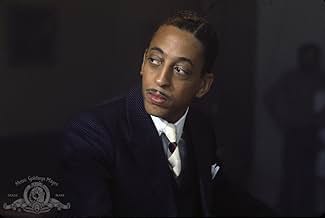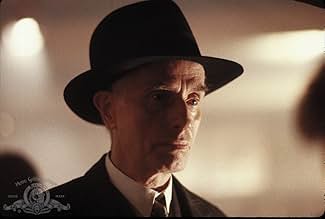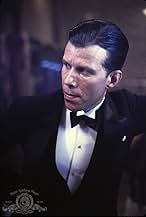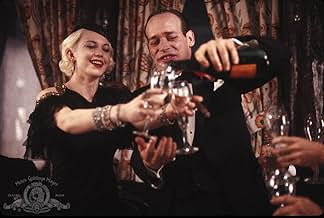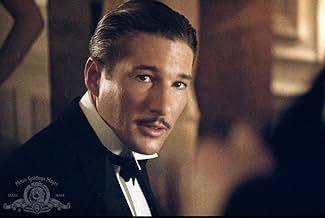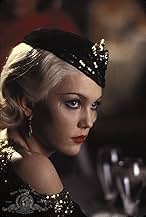AVALIAÇÃO DA IMDb
6,6/10
21 mil
SUA AVALIAÇÃO
Conheça os músicos de jazz, dançarinos, proprietários e convidados do Cotton Club em Harlem de 1928 a 1930.Conheça os músicos de jazz, dançarinos, proprietários e convidados do Cotton Club em Harlem de 1928 a 1930.Conheça os músicos de jazz, dançarinos, proprietários e convidados do Cotton Club em Harlem de 1928 a 1930.
- Direção
- Roteiristas
- Artistas
- Indicado a 2 Oscars
- 1 vitória e 9 indicações no total
Laurence Fishburne
- Bumpy Rhodes
- (as Larry Fishburne)
John P. Ryan
- Joe Flynn
- (as John Ryan)
Avaliações em destaque
The first time I saw this movie I loved the music and dancing and appreciated the setting. I found it strange and couldn't follow it properly. I watched it a second and third time, partly to see the dancing again, and listen to the music, and the plot completely grew on me. I absolutely love this movie. It is complex, and extremely accurate in its portrayal of the time when gangsters owned stars. If you love jazz music and know a little about its history, you will be enraptured by this movie.
The acting is incredible, and highlights the subtle twists in the plot beautifully. The cinematography is done in a most expert fashion. Richard Gere and Gregory Hines are absolutely charming, and Diane Lane is perfect is Vera Cicero. Lonette McKee has one of the most beautiful voices you will ever hear, it is no wonder she received a Tony award. Any viewer will be surprised by the guest appearances including Nicholas Cage, Bob Hoskins, Lawrence Fishburne, and on-screen and real-life brother of Gregory, Maurice Hines. Not only one of Coppola's best, but one of the best of all time.
The acting is incredible, and highlights the subtle twists in the plot beautifully. The cinematography is done in a most expert fashion. Richard Gere and Gregory Hines are absolutely charming, and Diane Lane is perfect is Vera Cicero. Lonette McKee has one of the most beautiful voices you will ever hear, it is no wonder she received a Tony award. Any viewer will be surprised by the guest appearances including Nicholas Cage, Bob Hoskins, Lawrence Fishburne, and on-screen and real-life brother of Gregory, Maurice Hines. Not only one of Coppola's best, but one of the best of all time.
The Cotton Club is a dazzling, complex film that attempts so much it would be almost impossible for nearly any director to pull it off. But Francis Ford Coppola is not any director, so The Cotton Club is not just any movie. Rather, it succeeds at practically all levels and is certainly a film worth coming back to again and again.
Set in Harlem in the late 1920s, we are introduced to a group of Jazz Age-products, people who see themselves exactly as they are but all hope to go somewhere better. Two story lines occupy the plot; we get a good-looking young musician Dixie Dwyer (Richard Gere) who gets involved in the mob after falling for one of the gangster's girlfriends (Diane Lane) and we get the story of a very talented black dancer (Gregory Hines) trying to prove his love to a half-black and half-white chorus girl who seems to struggle with her place in this more or less racist society. Almost every night, everyone gathers at The Cotton Club, one of the most famous clubs in the city and the blacks entertain while the whites drink and watch. But Coppola gives us a view from all angles so it doesn't feel as if we are missing anything important.
One of the biggest achievements of this film is its staging of the dance sequences, which are to say the least quite exquisite. Filled with colorful costumes and some mind-boggling tap numbers, at times you may forget that this is also a gangster picture. Indeed, some scenes feel just like Coppola's The Godfather with its quick bursts of violence but also in its tone of sad, elegiac setting. People come and go and some regret the things they do, but the music lives on. The acting is also very strong as Gere and Lane are quite wonderful in their first of three films together. Both were very good-looking and they do bring out the best in each other. Two supporting actors that really do steal the show are Bob Hoskins and Fred Gwynne as a mob boss and his head bodyguard. They share a tenacity and ferociousness in their dealings, but also have one really terrific scene involving Gwynne coming to see Hoskins after being kidnapped. A young Nicolas Cage also shows here he had incredible potential.
This Broadway version of the gangster film so familiar in Hollywood refreshes both genres as we see the similarities between the two. Indeed, many of the participators in the entertainment were also involved in the mob and Coppola shows how the two lives intertwine and bring a lot of trouble to everyone. This may seem as a strange mixing of genres and story lines for some people, but it is well worth the two hours. It is funny, sad, violent, poetic but also enormously entertaining and isn't that what the movies are all about? Coppola seems to think so.
Set in Harlem in the late 1920s, we are introduced to a group of Jazz Age-products, people who see themselves exactly as they are but all hope to go somewhere better. Two story lines occupy the plot; we get a good-looking young musician Dixie Dwyer (Richard Gere) who gets involved in the mob after falling for one of the gangster's girlfriends (Diane Lane) and we get the story of a very talented black dancer (Gregory Hines) trying to prove his love to a half-black and half-white chorus girl who seems to struggle with her place in this more or less racist society. Almost every night, everyone gathers at The Cotton Club, one of the most famous clubs in the city and the blacks entertain while the whites drink and watch. But Coppola gives us a view from all angles so it doesn't feel as if we are missing anything important.
One of the biggest achievements of this film is its staging of the dance sequences, which are to say the least quite exquisite. Filled with colorful costumes and some mind-boggling tap numbers, at times you may forget that this is also a gangster picture. Indeed, some scenes feel just like Coppola's The Godfather with its quick bursts of violence but also in its tone of sad, elegiac setting. People come and go and some regret the things they do, but the music lives on. The acting is also very strong as Gere and Lane are quite wonderful in their first of three films together. Both were very good-looking and they do bring out the best in each other. Two supporting actors that really do steal the show are Bob Hoskins and Fred Gwynne as a mob boss and his head bodyguard. They share a tenacity and ferociousness in their dealings, but also have one really terrific scene involving Gwynne coming to see Hoskins after being kidnapped. A young Nicolas Cage also shows here he had incredible potential.
This Broadway version of the gangster film so familiar in Hollywood refreshes both genres as we see the similarities between the two. Indeed, many of the participators in the entertainment were also involved in the mob and Coppola shows how the two lives intertwine and bring a lot of trouble to everyone. This may seem as a strange mixing of genres and story lines for some people, but it is well worth the two hours. It is funny, sad, violent, poetic but also enormously entertaining and isn't that what the movies are all about? Coppola seems to think so.
This is a great movie. I personally don't think the beautiful Diane Lane could be in a bad flick, she would make the worst one good. I was impressed with Richard Geres musical ability as he played his own coronet and sounded as good as anyone I've ever heard. The dancing was superb, the costumes beautiful and the plot authentic. It took me back to the great musicals of the forties and fifties. I was raised in the waning days of the era of this movie, the thirties, and I could almost hear my Dad talking about the evils of the big cities while we listened to the radio news of gangsters and shootouts. I would recommend this movie to anyone. I rate it 10/10.
Francis Ford Coppola's The Cotton Club is every bit as dazzling, chaotic and decadent as one might imagine the roaring twenties would have been. it's set in and revolves around the titular jazz club, conducting a boisterous, kaleidoscope study of the various dames, dapper gents, hoodlums, harlots and musicians who called it home. Among them are would be gangster Dixie Dwyer (a slick Richard Gere), Sandman Williams (Gregory Hines), a young Bumpy Johnson (Laurence Fishburne) and renowned psychopathic mobster Dutch Schultz (a ferocious James Remar). Coppola wisely ducks a routine plot line in favor of a helter skelter, raucous cascade of delirious partying, violence and steamy romance, a stylistic choice almost reminiscent of Robert Altman. Characters come and go, fight and feud, drink and dance and generally keep up the kind of manic energy and pizazz that only the 20's could sustain. The cast is positively stacked, so watch for appearances from Nicolas Case, Bob Hoskins, Diane Lane, John P. Ryan, James Russo, Fred Gwynne, Allen Garfield, Ed O Ross, Diane Venora, Woody Strode, Giancarlo Esposito, Bill Cobbs, Sofia Coppola and singer Tom Waits as Irving Stark, the club's owner. It's a messily woven tapestry of crime and excess held together by brief encounters, hot blooded conflict and that ever present jazz music which fuels the characters along with the perpetual haze of booze and cigarette smoke. Good times.
inspired by photographs of the legendary Cotton Club in Harlem, some shots appear exactly as they were (now in colour). I noticed Dutch Schultz's slumped pose when he is shot is exactly that of the police photograph, though he died several hours later (see William Burroughs "The Last Words Of Dutch Schultz"). The actors often play too broad (Diane Lane), and Richard Gere shows his lazy, grinning acting here too. However, many notable smaller roles for Gregory Hines (and his brother), Bob Hoskins, Laurence Fishburne and others who make it well worth watching. It is true that $40 million could have been used better, but when you consider both Bob Evans and Coppola's involvement it seems with hindsight that they were asking for trouble. The music deserves special credit, as do the tap sequences (which i gather were shortened and some cut - what a shame). Mostly Duke Ellington classics. As i've already suggested the look is a perfect recreation of the time, but sadly the plot is patchy, some dialogue weak and it has been said before - there is no chemistry between the romantic leads. 9/10
Você sabia?
- CuriosidadesWhen Francis Ford Coppola called up Bob Hoskins to offer him a part, the actor didn't believe it was really him. Coppola introduced himself, to which Hoskins replied, "Yeah, and this is Henry the fucking Eighth", and hung up.
- Erros de gravaçãoDuring the montage song Ill Wind there is a shot of coins and bills being poured out. The dimes in the shot are Roosevelt dimes, not produced until 1946.
- Cenas durante ou pós-créditosIn the original version, the opening credits were intercut with dancers performing "The Mooche." In the 2019 revision, the dancing is eliminated and the credits roll straight through, but have been joined with straight cuts rather than dissolves. Additionally, Coppola has changed his billing from "Francis Coppola" to "Francis Ford Coppola." Finally, restoration credits have been added after the end titles.
- Versões alternativasIn 2019, Lionsgate released a director's cut running 139 minutes, titled "The Cotton Club Encore". This version gave more space to the Williams brothers and Lila Rose, restoring three full musical numbers and extending others, and trimming scenes with impersonations of 1920s celebrities.
- ConexõesEdited into Lonette McKee: Ill Wind (1984)
- Trilhas sonorasHow Come You Love Me Like You Do?
Written by Gene Austin and Roy Bergere
Principais escolhas
Faça login para avaliar e ver a lista de recomendações personalizadas
- How long is The Cotton Club?Fornecido pela Alexa
Detalhes
- Data de lançamento
- País de origem
- Idiomas
- Também conhecido como
- El Cotton Club. Centro de la mafia
- Locações de filme
- Prospect Hall, Brooklyn, Nova Iorque, Nova Iorque, EUA(church, order given at bar, Hoofer's Club, ballroom proposal)
- Empresas de produção
- Consulte mais créditos da empresa na IMDbPro
Bilheteria
- Orçamento
- US$ 58.000.000 (estimativa)
- Faturamento bruto nos EUA e Canadá
- US$ 25.928.721
- Fim de semana de estreia nos EUA e Canadá
- US$ 2.903.603
- 16 de dez. de 1984
- Faturamento bruto mundial
- US$ 25.928.721
- Tempo de duração
- 2 h 9 min(129 min)
- Cor
- Proporção
- 1.85 : 1
Contribua para esta página
Sugerir uma alteração ou adicionar conteúdo ausente



